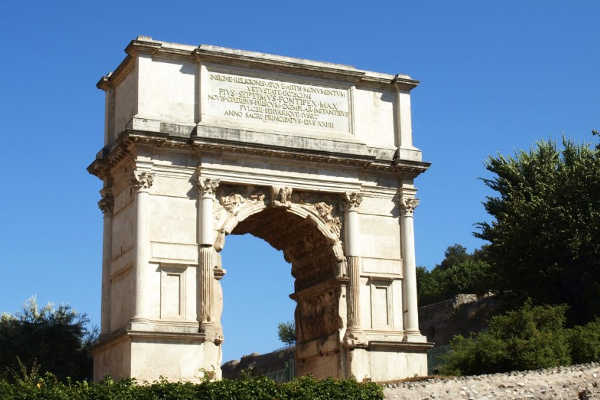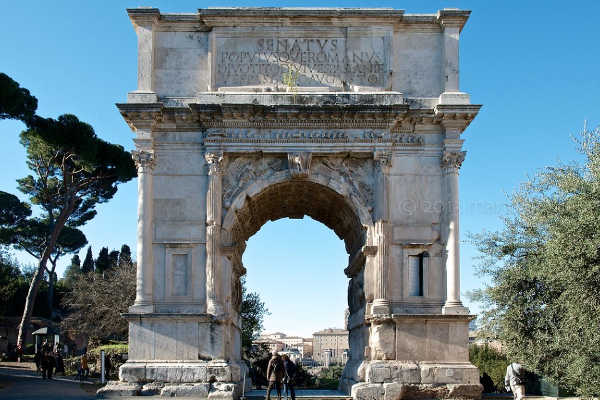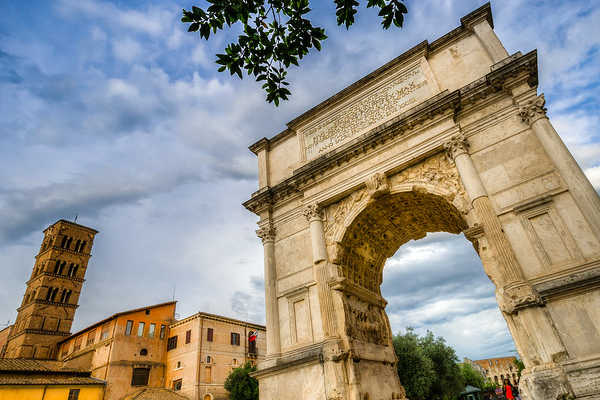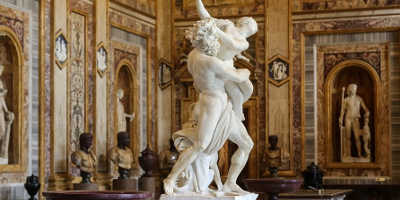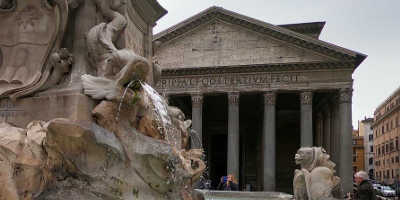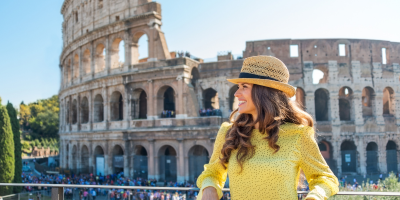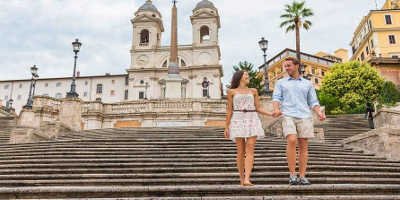Arch of Titus, Rome
The Arch of Titus is one of the oldest of two remaining arches from the Roman Empire.
The 50ft tall monument is located along the Via Sacra, the busiest road in the ancient city of Rome, and sits at the south-eastern end of the famous archaeological site of the Roman Forum. This grand arch was one of the first of its kind and is said to have influenced the design of the Arc de Triomphe in Paris.
The History of the Arch
The arch was built in 82 AD by Emperor Domitian as a tribute to his older brother, Emperor Titus, after his death. The identity of the architect is unknown, with no surviving documents from the arch’s creation. This arch commemorates the military triumphs of Titus and his father Vespasian, in particular, their victory in the Jewish war which ended in 70 AD. The images carved into the stone celebrate the destruction of the temple in Jerusalem and the divinity of Titus.
When the army returned from Jerusalem, they would have paraded the spoils of war into the city in a grand fashion and the arch was probably built over the location of the parade. Whilst the arch depicts a victorious time, the battles would have been incredibly violent with the general of the opposing army being ceremoniously killed after the battle. The General of the Jewish army was Simon, Son of Giora. The arch held a great deal of symbolic importance to the people of Rome however it was created to humiliate the Jewish people that it had defeated. Due to this, many Jewish people of the past would refuse to walk beneath the arch.
Despite its age, the arch remained considerably durable, even throughout the fall of Rome in the 5th century. However, the arch needed restoration after its slow deterioration of its outer areas and exterior columns. The repairs began in 1817 and were completed by 1821.
The Decoration of the Arch
Within the arch, you will notice scenes depicting Roman soldiers in a triumphant parade carrying the spoils of war form Jerusalem back to the city of Rome. Raised above their heads are golden trumpets, a show table which was used to place bread before god and, most importantly, the menorah. The menorah is an important symbol of the Jewish faith and is displayed with great prominence in the stone carving both to highlight the power of Rome, and to belittle the Jews whom they had just defeated. Research has found that these items were painted in yellow ochre when they were originally made. The arch was funded by Jewish money and was built by Jewish slaves, therefore it is as much a demonstration of the Roman’s brutality as it was a celebration of Titus’s successes.
A four horsed chariot is carved into the opposite panel with Titus shown next to divine entities. Winged Victory is crowning him with a laurel wreath, and this is one of the first times that human and mythical entities were shown together in a scene such as this.
Above these carvings are intricate, floral carved panels which lead up to a relief of Titus being carried to heaven on the back of an eagle. Around the rest of the arch are further carvings of winged women and many inscriptions. The arch also features fluted and unfluted columns, the latter of which were added during the restorations of the 19th century.
Why Arch of Titus is Important?
The arch is important from a historical as well as a religious and political point of view. The arch represents the glory of the Roman Empire, with Titus being viewed in a god-like way, worshiped for his successes. The arch also celebrates how Titus and his father, Vespasian, conquered the people of Jerusalem who were revolting against their Roman rulers. The symbols on the arch depict the parade of the artefacts out of the temple of Jerusalem into Rome and represent the prophecy in the Gospels that ‘not one stone of the Jerusalem temples will remain upon the other.’ The arch symbolises the final episode of the destruction of the Temple in Jerusalem, with the beginning of the 2,000-year-long exile.
It was not only the building of the arch that was an affront to the Jewish people. It was subsequently used by other influential figures to enforce the dominance of other powers over the Jews and to force allegiance. In 1555 Pope Paul the 4th began bringing the Jewish community to the arch once a year to stand underneath it and pledge their allegiance to Rome. The arch may mean different things depending on the individual, but there is no doubt this is a significant and symbolic artefact from ancient Rome.
How Can You See the Arch of Titus?
The arch is located in the heart of the Roman Forum, sitting alongside the once-thriving centre city street of the Roman Empire. There are an array of ruins scattering the area, including the funeral altar of Julius Caesar, the House of the Vestals, as well as the Curia. Viewing other important buildings and monuments in the area will help you to gain a greater understanding of the power of the Roman Empire. There are few signs or information points within the Forum so it is recommended that you travel with a tour guide to get the most out of your adventure into ancient history.

